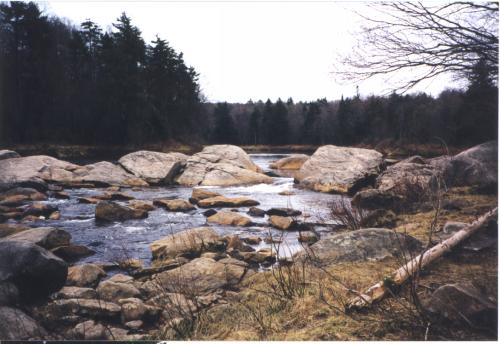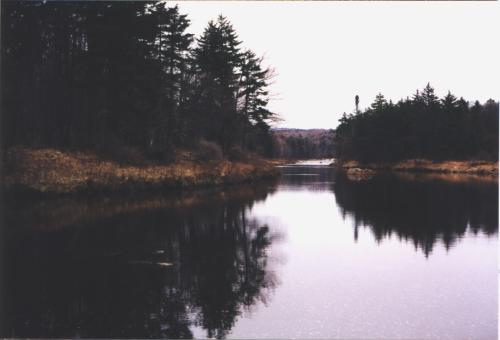
not seen in this photo, is located just a few miles downstream
of the private land boundary of the Adirondack League Club.
April 19, 1998.
 |
| The South Branch of the Moose River at Remsen Falls.
The small waterfall, not seen in this photo, is located just a few miles downstream of the private land boundary of the Adirondack League Club. April 19, 1998. |
"[A] river is, in fact, navigable, on which boats, lighters, or rafts may be floated to market ... [Additionally,] the public have a right of way in every stream which is capable, in its natural state and its ordinary volume of water, of transporting, in a condition fit for market, the products of the forests or mines, or of the tillage of the soil upon its banks. It is not essential to the right that the property to be transported should be carried in vessels, or in some other mode, whereby it can be guided by the agency of man, provided it can ordinarily be carried safely without such guidance .... If it is so far navigable or floatable in its natural state and its ordinary capacity, as to be of public use in the transportation of property, the public claim to such use ought to be liberally supported"A lower court also affirmed that a river "does not lose this characteristic [of navigability] even if it has fallen into disuse for a hundred years."
"[It is not essential for a river to] be capable of being ... navigated against its current. ... Nor is it essential to the easement that the capacity of the stream ... should be continuous ... at all seasons of the year. ... If it is ordinarily subject to periodical fluctuations in the volume and height of its water, attributable to natural causes, and recurring as regularly as the seasons, and if its periods of high water or navigable capacity ordinarily continue a sufficient length of time to make it useful as a highway, it is subject to the public easement."
 |
| Looking upstream from Remsen Falls.
April 19, 1998. |
"[The] defendants are correct, however, that the existence of occasional natural obstructions do not destroy the navigability of a river. ... Following naturally from this proposition is that in order to circumvent these occasional obstacles, the right to navigate carries with it the incidental privilege to make use, when absolutely necessary, of the bed and banks, including the right to portage on riparian lands ... On the other hand, any use of private river beds or banks that is not strictly incidental to the right to navigate gives rise to an action for trespass."And finally, in a decision that reflects the changing attitudes of the modern era, the court upheld the rights of paddlers statewide. A river's test for navigability, under the precendent established here, now includes the ability of a waterway to be used for recreational purposes such as canoeing and kayaking, and not simply its ability to be used in commerce:
"The declining need to use rivers for commercial logging coincides with changing attitudes toward the preservation of our natural resources. Rivers, long-recognized as unique natural resources, are no longer primarily subjects of commercial exploitation and gain but instead are valued in their own right as a means of travel. ... In line with these modern circumstances and our precedents, we are satisfied that recreational use should be part of the navigability analysis. ... [The ALC's] fear that consideration of recreational use unduly broadens the common law standard and threatens private property rights is unfounded. We do not broaden the standard for navigability in fact, but merely recognize that recreational use fits within it."The dissenting opinion in the case, which called for the summary judgement on the navigability of the Moose to be granted, agreed that recreational use should be taken into account when considering the navigability of a waterway.